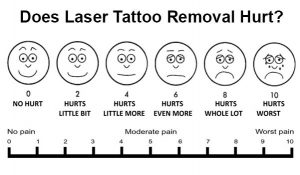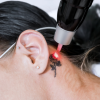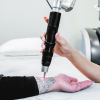Last Updated on September 22, 2025
Have you ever wondered what most people ask us during a consultation for tattoo removal? Generally, there is a lot of confusion about the procedure, all the marketing claims they have heard about as well as queries and concerns regarding their skin quality following the laser treatment.
We see a variety of clients; from those who want a tattoo fade for a cover-up or a desire for complete removal. We like to educate and inform on all aspects of tattoo removal before they go ahead. We have found that explaining the science behind it is a great start to understanding how it all works! Here are our most frequently asked questions.
How long will it take to remove my tattoo?
The rule of thumb is to say anywhere from 7-12 treatments, however for tattoos that are mostly shaded (ink is less deep) and for very old tattoos (the body has been busy trying to remove ink already) the time can be less.
Tattoo removal is definitely multi-factorial including the location of the tattoo, the age of the tattoo, the health of the persons immune system, the type of ink used, the colour of the ink in some cases, and whether there is any pre-existing scarring from the original tattoo procedure.
How can the speed of tattoo removal be increased?
Did you know that the laser does not remove the ink? It is your body that does! The lymphatic system is a marvellous ink moving system that needs to be healthy and working well for the fastest results.
Fragments of pigment are gradually carried away through the body’s natural filtration pathways, which is why tattoo ink & lymph nodes are discussed in relation to how the immune system processes ink particles.
The lymphatic system connects directly to the circulatory system. Nutrient-rich foods that boost immune system strengthen lymphatic function. These steps help the lymphatic system perform at its best.
Laser pulse speed does not affect tattoo removal results, experts say
According to Dr. Asraf Badawi, European Assistant Professor of Dermatology at the National Institute of Laser Enhanced Sciences and a world leader in laser technology, the speed of the laser pulse (nano versus pico) has no significant impact on how quickly a tattoo is removed.
We have seen plenty of each (pico and nano) come to visit us and have witnessed no difference in speed either. There is a mind field of misinformation with marketing out there. One prominent pico company has even been taken to court for false advertising.
When lasers are misused, your skin pays the price
An application patch (PFD) for multiple laser passes per treatment is trying to gain some momentum in the tattoo removal world. Our training company in the U.S.A with 30 years experience in tattoo removal found that not only are they expensive, they seem to block the penetration of the laser rather than aiding it. It also increases pain without any visible reduction in treatments required and will increase healing time required following treatment.
It’s basically a really expensive silicon bandage that gullible clinics use in an attempt to reduce treatments. Another marketing hype it seems. If too high a power is used, or the wrong laser is used, the skin will become damaged and the time for tattoo removal will be lengthened.
Will my skin look natural again after laser tattoo removal?
Yes and no. In most cases, skin does return to its natural appearance, with scarring said to occur in less than 1% of treatments. We shared one of our blog some of the tattoo gone wrong stories we have seen.
If you have pre-existing scarring either from the tattoo artist or from laser treatment, the scar will need to be removed with another laser. Scarred tattoos do take longer to remove as ink traps within the denser tissue.
For the best results, you need experienced clinicians, machines designed specifically for tattoo removal (with correct wavelengths, square spot size, and consistent power), proper care of your body, and a little patience. Together, these factors make a world of difference in achieving effective removal and protecting your skin.
Are there any side effects of laser tattoo removal?
The treated area of skin can feel sunburnt for a few hours and there can be a small amount of micro-bleeding, swelling and very mild scabbing. Newer tattoos can blister and red ink tattoos commonly blister.
As mentioned above, there is a significant difference in who performs the treatment and the laser machine used. As the skin heals (3 days +), the skin can become itchy. Laser tattoo removal side effects should be very minimal and short lived. We provide post treatment using a skin healing laser and recommend a healing balm. Both these applications can significantly reduce itchiness as well as fast track the healing process.
Does tattoo removal hurt?
To be completely honest, tattoo removal does hurt. Larger tattoos are helped by our specifically applied laser targeting nerve pathways (those that create the sensation of pain). This “cold laser” helps reduce pain, heals skin faster and opens lymph channels for faster ink movement.
The use of a cooling machine during treatment makes a significant difference to comfort. Numbing cream also can be used however due to absorption of white particles from the cream itself, this will block some of the laser light and can increase the number of overall treatments required by a visit or two.
The type of laser matters more than you think
There are different lasers used in tattoo removal. Do your research, read reviews and be wary of anyone that guarantees removal by a certain time or number of treatments. It is a scientific process and every tattoo is different as is the body. Cost maybe isn’t always the criterion to choose which clinic you attend. You might end up paying a lot more in the end due to inexperience.
How many sessions to remove a tattoo?
Everyone’s tattoo fades differently. Your skin type, immune response, and tattoo all affect how many tattoo removal sessions you’ll need. It can take 10–12 sessions for moderate tattoos, while more complex or heavily coloured tattoos may require significantly more.
After 1 session, you may notice the tattoo looks slightly faded or has developed a white frosting effect immediately after treatment. For blackout tattoos, which absorb the laser energy most efficiently, some lightening is visible after the first session, though the design will still be very clear.
After 3 sessions, you’ll see noticeable fading, especially in black or dark-coloured areas. The outlines may start to blur, and shaded regions will look patchier or lighter. Note that tattoo will still be visible.
How much does tattoo removal cost?
The cost of tattoo removal is based on the size of the tattoo:
- Postage Stamp (2 cm x 2 cm) – $90 per treatment
- Extra Small (5 cm x 5 cm) – $125 per treatment
- Credit Card (10 cm x 5 cm) – $160 per treatment
- Passport (15 cm x 10 cm) – $270 per treatment
- Half A4 (15 cm x 20 cm) – $360 per treatment
- A4 (30 cm x 20 cm) – $580 per treatment
Each treatment is carefully priced to reflect the time and resources needed for safe, effective removal. We also offer excellent discounts when you pre-purchase a series of treatments, making it easier and more affordable to complete your tattoo removal journey.
Renude Laser Clinic also accepts Zip Pay, so you can start your tattoo removal without paying everything upfront and spread the cost over time.
Smarter Choices Lead to Better Outcomes – Renude Laser
Do your research, read reviews and be wary of anyone that guarantees removal by a certain time or number of treatments. It is a scientific process and every tattoo is different as is the body. Cost maybe isn’t always the criterion to choose which clinic you attend. You might end up paying a lot more in the end due to inexperience.
Renude Laser Tattoo Removal Clinic in Sydney is the first in the world to offer free pre- and post-treatment with Cold or Low-Level Laser technology. Experience tattoo removal at its finest. Reserve your spot now.












